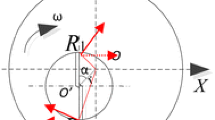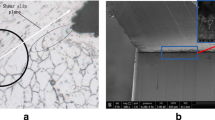Abstract
In micro-milling, cutting forces are driven by many parameters, including feed per tooth, depth of cut, rake angle and machined material. Because of size effects, issues inherent in the micro-milling process, such as chatter, edge radius or tool deflection, influence the cutting forces making it difficult to understand the process. To overcome this problem, the best solution is to perform experiments independently on each parameter. With orthogonal and oblique micro-cutting experiments, chip formation is investigated with fewer parameters. This study aimed to model micro-cutting using the results obtained from orthogonal and oblique micro-cutting experiments, based on tube turning ignoring dynamic considerations. It was experimentally observed that a jump in cutting forces occurs when the uncut chip thickness decreases, described as a transient regime between ploughing and shearing dominant regimes. The ploughing regime for low uncut chip thicknesses is characterised by a normal force greater than the cutting force. At higher uncut chip thicknesses, the cutting force is dominant. A phenomenological model was developed to take into account the divergence in cutting forces at low uncut chip thicknesses. The model was divided into two terms that model, respectively, ploughing and shearing regimes with a continuous transient regime. The model reproduced the behaviour quite well and could be enriched with more parameters.
Similar content being viewed by others
References
Cheng K, Huo D (2013) Micro-cutting fundamentals and applications. Wiley
Dornfeld D, Min S, Takeuchi Y (2006) Recent advances in mechanical micromachining. CIRP Ann Manuf Technol 55:745–768. doi:10.1016/j.cirp.2006.10.006
Aramcharoen A, Mativenga PT (2009) Size effect and tool geometry in micromilling of tool steel. Precis Eng 33:402–407. doi:10.1016/j.precisioneng.2008.11.002
Sawangsri W, Cheng K (2016) An innovative approach to cutting force modelling in diamond turning and its correlation analysis with tool wear. Proc Inst Mech Eng Part B J Eng Manuf 230:405–415
Mian A, Driver N, Mativenga PT (2011) Identification of factors that dominate size effect in micro-machining. Int J Mach Tools Manuf 51:383–394. doi:10.1016/j.ijmachtools.2011.01.004
Biermann D, Kahnis P (2010) Analysis and simulation of size effects in micromilling. Prod Eng 4:25–34
Afazov SM, Ratchev SM, Segal J, Popov AA (2012) Chatter modelling in micro-milling by considering process nonlinearities. Int J Mach Tools Manuf 56:28–38. doi:10.1016/j.ijmachtools.2011.12.010
Afazov SM, Zdebski D, Ratchev SM et al (2013) Effects of micro-milling conditions on the cutting forces and process stability. J Mater Process Technol 213:671–684. doi:10.1016/j.jmatprotec.2012.12.001
Malekian M, Park SS, Jun MBG (2009) Modeling of dynamic micro-milling cutting forces. Int J Mach Tools Manuf 49:586–598
Vogler MP, DeVor RE, Kapoor SG (2003) Microstructure-level force prediction model for micro-milling of multi-phase materials. J Manuf Sci Eng 125:202–209
Mian AJ, Driver N, Mativenga PT (2010) A comparative study of material phase effects on micro-machinability of multiphase materials. Int J Adv Manuf Technol 50:163–174
Bissacco G, Hansen HN, Slunsky J (2008) Modelling the cutting edge radius size effect for force prediction in micro milling. CIRP Ann Manuf Technol 57:113–116. doi:10.1016/j.cirp.2008.03.085
Armarego EJA (1998) A generic mechanics of cutting approach to predictive technological performance modeling of the wide spectrum of machining operations. Mach Sci Technol 2:191–211
Altintas Y, Jin X (2011) Mechanics of micro-milling with round edge tools. CIRP Ann Manuf Technol 60:77–80
Jing X, Li H, Wang J, Tian Y (2014) Modelling the cutting forces in micro-end-milling using a hybrid approach. Int J Adv Manuf Technol 73:1647–1656. doi:10.1007/s00170-014-5953-x
Rodríguez P, Labarga JE (2015) Tool deflection model for micromilling processes. Int J Adv Manuf Technol 76:199–207. doi:10.1007/s00170-014-5890-8
Kang IS, Kim JS, Kim JH et al (2007) A mechanistic model of cutting force in the micro end milling process. J Mater Process Technol 187–188:250–255. doi:10.1016/j.jmatprotec.2006.11.155
Kang IS, Kim JS, Seo YW (2008) Cutting force model considering tool edge geometry for micro end milling process. J Mech Sci Technol 22:293–299. doi:10.1007/s12206-007-1110-x
Friedrich CR, Kulkarni VP (2004) Effect of workpiece springback on micromilling forces. Microsyst Technol 10:472–477. doi:10.1007/s00542-004-0375-6
Wang J, Gong Y, Abba G et al (2009) Chip formation analysis in micromilling operation. Int J Adv Manuf Technol 45:430–447
Fleischer J, Schulze V, Kotschenreuther J (2009) Extension of cutting force formulae for microcutting. CIRP J Manuf Sci Technol 2:75–80
Richard F (1999) Identification du comportement et évaluation de la fiabilité des composites stratifiés. UFC
Levenberg K (1944) A method for the solution of certain non-linear problems in least squares. Q Appl Math 2:164–168
Marquardt DW (1963) An algorithm for least-squares estimation of nonlinear parameters. J Soc Ind Appl Math 11:431–441
Merchant ME (1945) Mechanics of the metal cutting process. I. Orthogonal cutting and a type 2 chip. J Appl Phys 16(5):267–275
Author information
Authors and Affiliations
Corresponding author
Rights and permissions
About this article
Cite this article
Piquard, R., Thibaud, S., D’Acunto, A. et al. Phenomenological modelling of micro-cutting based on experimental results. Int J Adv Manuf Technol 88, 3429–3436 (2017). https://doi.org/10.1007/s00170-016-9047-9
Received:
Accepted:
Published:
Issue Date:
DOI: https://doi.org/10.1007/s00170-016-9047-9




